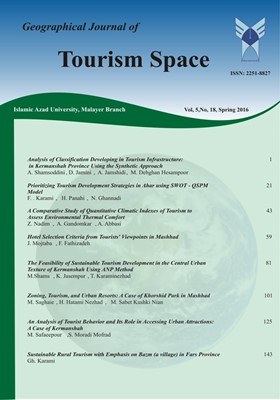An Analysis of Developing the Tourism Infrastructure in Kermanshah Using Synthetic Models
Subject Areas :
Keywords: Classification, Tourism, Kermanshah province, TOPSIS model, tourism infrastructure,
Abstract :
Tourism industry, considering its numerous benefits for societies from villages to cities, has attracted the attentions of politicians and planners. A major issue of tourism infrastructure is the balance between the number of tourists and existing infrastructure. Therefore, this study, which is a descriptive-analytical, applied research, attempts to prioritize and determine the degree of development of Kermanshah province in terms of enjoying tourism infrastructure. Archival and field methods have been used to obtain the necessary data. In conducting the research, eighteen indices related to tourism infrastructure have been used. In addition, in order to realize the research indices, the experts' questionnaires (30 experts specializing in tourism) have been used. In order to prioritize towns of the province, the synthetic technique (TOPSIS and AHP) has been used and in order to measure the development of the towns, cluster analysis has been adopted. Also, GIS software has been used to show the levels of development. The research findings showed that QasreShirin, Paveh and Kermanshah having the respective priority coefficients of 0.583, 0.569 and 0.512, would fall into the first, second and third ranks respectively. Also the three towns of Babajani, Dalahoo and Harsin, have the priority coefficients of 0.198, 0.279 and 0.279, and so occupy the lowest ranks in terms of enjoying tourism infrastructure. As a result, in terms of tourism infrastructure development, about 21 percent of the towns of Kermanshah province are on ‘very rich’ and ‘rich’ levels, 36 percent are on ‘fairly rich’ level, and 43 percent are on ‘poor’ and ‘very poor’ levels.

